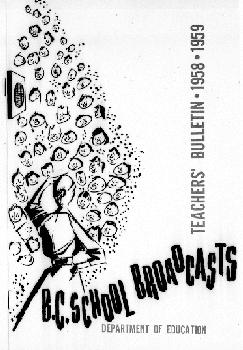School Radio Broadcasts

Although educational radio programmes had been broadcast in Vancouver as early as 1927, regularly-scheduled school broadcasts did not begin in British Columbia until 1936, when the Okanagan Valley Teachers’ Association aired a series of six programs on music appreciation on radio station CKOV in Kelowna.
Following the success of the Okanagan series, the Minister of Education, Dr. G. M. Weir, established a committee to investigate the potential of radio broadcasts as a teaching aid. The committee included Harry Charlesworth of the British Columbia Teachers’ Federation; Isabel Bescoby, the Director of the Elementary Correspondence Branch; and Ira Dilworth, manager of radio station CBR Vancouver and regional representative of the Canadian Broadcasting Corporation. A. R. (Alex) Lord, principal of the Vancouver Normal School, served as committee secretary and became a driving force in development of school broadcasts in British Columbia.
In 1938, the Department of Education provided a $500 grant to assist in the production of three series of broadcasts entitled Musical Pathways, Elementary Science, and Social Studies. The first programme was broadcast over the CBC network on 21 March 1938. New programmes were subsequently developed with funds provided by the Education Department and the Carnegie New York Trust.
The following year, 1939, the British Columbia Radio School was organized in conjunction with the CBC and the Department of Education. The CBC provided the Radio School with technical assistance and broadcasting facilities in its Vancouver affiliate, radio station CBR, while the Department of Education developed scripts and paid for the costs of broadcasting. Until 1946, the CBC and the Department of Education contributed equally to the salary of the Radio School's director; afterwards, the department assumed sole reponsibility for the position.
The first Director of School Broadcasts was Kenneth Caple, who was appointed in January 1940. Caple had been president of the Okanagan Valley Teachers’ Association when the Kelowna radio broadcasts were made four years earlier. He made an extensive study of school broadcasting in the United States and initiated several important changes in programming. Under his direction, programme guides and manuals were provided to teachers throughout the province. Programmes on modern languages, health, art appreciation and other school subjects were developed. Whimsical programmes — like Me and My School: Some Fun! — were also created. The number of radio stations carrying the broadcasts increased and by 1942 students in over 500 schools were listening to British Columbia Radio School programmes.
In 1944 Caple resigned from the Department of Education to become regional programme director for the CBC. Caple was succeeded as Director of School Broadcasts by Kelowna teacher Philip J. Kitley. Under Kitley the range of programming expanded to encompass a broad range of subjects suitable for Grades 1 to 12. Kitley also helped to develop a summer school course for teachers on the use of radio in the classroom.
By the mid-1950s over 1,500 schools were receiving school broadcasts on a regular basis, usually on Wednesday afternoons. The broadcasts dealt with a huge range of topics, from history and current events, to classical music and nuitrition. Many of the programmes also had practical applications. A series of programmes in 1957, for example, offered high school students tips on Where to Find a Job.
Kitley left the Radio School in 1959, to become the province's co-ordinator of teacher recruitment. He was replaced by Margaret Musselmen and Barrie Black. In 1969, the School Broadcasts directorate was merged with the department's Visual Education office to form Audio Visual Services. At the time of the amalgamation, the radio broadcasting service had peaked, in terms of the number schools who regularly received its programming. Soon after, however, school radio was usurped by a new broadcast medium — television.
In 1974, Audio Visual Services was disbanded and radio broadcasts were transferred to a new agency, the Provincial Educational Media Centre [PEMC]. PEMC had been established two years earlier as a television production and duplication facility at the British Columbia Institute of Technology. PEMC produced several avant garde programmes, including a series devoted to Leisure & Technology (27 February 1976). PEMC continued to work with the CBC to create school radio programmes until the early 1980s, by which time the newly-established Knowledge Network (an agency that developed out of PEMC) had developed an attractive and extensive schedule of school television programmes. Moreover, the use of new technologies — notably the VCR — meant that teachers and students no longer had organize their lessons around the set schedules of school radio broadcasts. Accordingly, the ministry decided to allocate resources to new technologies and in 1984 the provincial school radio service was closed.
"A Special School Broadcast about School Broadcasts" (30 April 1965)
Researched and written by Patrick A. Dunae
Sources:
Patrick A. Dunae, The School Record (1992), p. 76; Richard S. Lambert, School Broadcasting in Canada (Toronto: University of Toronto Press, 1963), pp. 34-39; Thomas Fleming and Tara Toutant, "'A Modern Box of Magic:' School
Radio in British Columbia, 1927-1984," Journal of Distance Education, Vol. 10, No. 1 (Spring 1995): 53-73.

